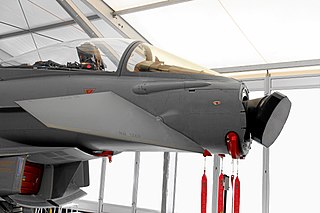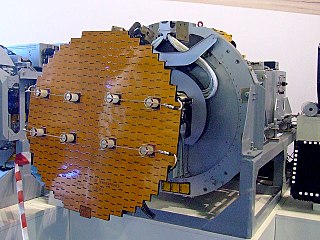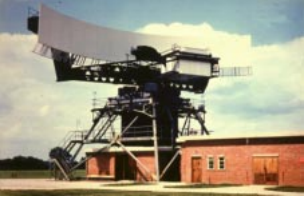Related Research Articles

Radar is a radiolocation system that uses radio waves to determine the distance (ranging), angle (azimuth), and radial velocity of objects relative to the site. It is used to detect and track aircraft, ships, spacecraft, guided missiles, motor vehicles, map weather formations, and terrain. A radar system consists of a transmitter producing electromagnetic waves in the radio or microwaves domain, a transmitting antenna, a receiving antenna and a receiver and processor to determine properties of the objects. Radio waves from the transmitter reflect off the objects and return to the receiver, giving information about the objects' locations and speeds.

In antenna theory, a phased array usually means an electronically scanned array, a computer-controlled array of antennas which creates a beam of radio waves that can be electronically steered to point in different directions without moving the antennas. The general theory of an electromagnetic phased array also finds applications in ultrasonic and medical imaging application and in optics optical phased array.

An active electronically scanned array (AESA) is a type of phased array antenna, which is a computer-controlled antenna array in which the beam of radio waves can be electronically steered to point in different directions without moving the antenna. In the AESA, each antenna element is connected to a small solid-state transmit/receive module (TRM) under the control of a computer, which performs the functions of a transmitter and/or receiver for the antenna. This contrasts with a passive electronically scanned array (PESA), in which all the antenna elements are connected to a single transmitter and/or receiver through phase shifters under the control of the computer. AESA's main use is in radar, and these are known as active phased array radar (APAR).

A pulse-Doppler radar is a radar system that determines the range to a target using pulse-timing techniques, and uses the Doppler effect of the returned signal to determine the target object's velocity. It combines the features of pulse radars and continuous-wave radars, which were formerly separate due to the complexity of the electronics.
Electronic counter-countermeasures (ECCM) is a part of electronic warfare which includes a variety of practices which attempt to reduce or eliminate the effect of electronic countermeasures (ECM) on electronic sensors aboard vehicles, ships and aircraft and weapons such as missiles. ECCM is also known as electronic protective measures (EPM), chiefly in Europe. In practice, EPM often means resistance to jamming. A more detailed description defines it as the electronic warfare operations taken by a radar to offset the enemy's countermeasure.
A low-probability-of-intercept radar (LPIR) is a radar employing measures to avoid detection by passive radar detection equipment while it is searching for a target or engaged in target tracking. This characteristic is desirable in a radar because it allows finding and tracking an opponent without alerting them to the radar's presence. This also protects the radar installation from anti-radiation missiles (ARMs).

The AN/APG-68 radar is a long range Pulse-doppler radar designed by Westinghouse to replace AN/APG-66 radar in the F-16 Fighting Falcon. The AN/APG-68(V)8 and earlier radar system consists of the following line-replaceable units:
Monopulse radar is a radar system that uses additional encoding of the radio signal to provide accurate directional information. The name refers to its ability to extract range and direction from a single signal pulse.

A passive electronically scanned array (PESA), also known as passive phased array, is an antenna in which the beam of radio waves can be electronically steered to point in different directions, in which all the antenna elements are connected to a single transmitter and/or receiver. The largest use of phased arrays is in radars. Most phased array radars in the world are PESA. The civilian microwave landing system uses PESA transmit-only arrays.

The AN/SPS-48 is a US naval electronically scanned array, air search three-dimensional radar system manufactured by ITT Exelis and deployed in the 1960s as the primary air search sensor for anti-aircraft warships. The deployment of the AN/SPY-1 and the end of the Cold War led to the decommissioning of many such ships, and many of these vessel's AN/SPS-48 sets were reused on aircraft carriers and amphibious ships where it is used to direct targets for air defense systems such as the Sea Sparrow and RIM-116 SAM missiles. Existing sets are being modernized under the ROAR program to AN/SPS-48G standard for better reliability and usability.

A radar display is an electronic device that presents radar data to the operator. The radar system transmits pulses or continuous waves of electromagnetic radiation, a small portion of which backscatter off targets and return to the radar system. The receiver converts all received electromagnetic radiation into a continuous electronic analog signal of varying voltage that can be converted then to a screen display.
A radar system uses a radio-frequency electromagnetic signal reflected from a target to determine information about that target. In any radar system, the signal transmitted and received will exhibit many of the characteristics described below.

The AN/FPS-16 is a highly accurate ground-based monopulse single object tracking radar (SOTR), used extensively by the NASA crewed space program, the U.S. Air Force and the U.S. Army. The accuracy of Radar Set AN/FPS-16 is such that the position data obtained from point-source targets has azimuth and elevation angular errors of less than 0.1 milliradian and range errors of less than 5 yards (5 m) with a signal-to-noise ratio of 20 decibels or greater.
Radar engineering details are technical details pertaining to the components of a radar and their ability to detect the return energy from moving scatterers — determining an object's position or obstruction in the environment. This includes field of view in terms of solid angle and maximum unambiguous range and velocity, as well as angular, range and velocity resolution. Radar sensors are classified by application, architecture, radar mode, platform, and propagation window.
Frequency agility is the ability of a radar system to quickly shift its operating frequency to account for atmospheric effects, jamming, mutual interference with friendly sources, or to make it more difficult to locate the radar broadcaster through radio direction finding. The term can also be applied to other fields, including lasers or traditional radio transceivers using frequency-division multiplexing, but it remains most closely associated with the radar field and these other roles generally use the more generic term "frequency hopping".

The AMES Type 82, also widely known by its rainbow codename Orange Yeoman, was an S-band 3D radar built by the Marconi Company and used by the Royal Air Force (RAF), initially for tactical control and later for air traffic control (ATC).

RX12874, also known as the Passive Detection System (PDS) and by its nickname "Winkle", was a radar detector system used as part of the Royal Air Force's Linesman/Mediator radar network until the early 1980s. Winkle passed out of service along with the rest of the Linesman system as the IUKADGE network replaced it.

The AMES Type 85, also known by its rainbow code Blue Yeoman, was an extremely powerful early warning (EW) and fighter direction (GCI) radar used by the Royal Air Force (RAF) as part of the Linesman/Mediator radar network. First proposed in early 1958, it was eleven years before they became operational in late 1968, by which time they were already considered obsolete. The Type 85 remained the RAF's primary air defense radar until it was replaced by Marconi Martello sets in the late-1980s as part of the new IUKADGE network.
Martello is a family of phased array radar systems developed by Marconi Electronic Systems in the 1970s and introduced operationally in the early 1980s. They provided long-range early warning capabilities but also had the accuracy needed for interception plotting and "putting on" of other weapons systems like surface-to-air missiles. The name comes from the Martello towers that provided defence in earlier years.
The AR-3D was a military air traffic control and early warning radar developed by Plessey and first produced in 1975. It used a pencil beam and simple frequency scanning system known as "squint scan" to produce a low-cost 3D radar system that was also relatively mobile. About 23 were produced in total and found sales around the world into the early 1980s.
References
Citations
- ↑ Gough 1993, pp. 320–321.
- ↑ Gough 1993, p. 320.
- 1 2 3 Gough 1993, p. 321.
- 1 2 Burr 2010, p. 7.5.
- 1 2 3 Pfister 1980, p. 628.
- 1 2 3 4 5 6 7 8 9 10 11 12 Burr 2010, p. 7.6.
- ↑ IUKADGE (PDF) (Technical report). Forecast International. April 1997. p. 6.
- ↑ Carle, Gordon (9 September 2011). "Type 93".
- 1 2 Burr 2010, p. 7.7.
- ↑ Burr 2010, p. 7.8.
- ↑ Carle, Gordon (10 May 2010). "Departure of the Type 93 radar". p. see images.
Bibliography
- Pfister, Gerhard (September 1980). "The Series 320 Radar: Three-Dimensional Air Surveillance for the 1980s" . IEEE Transactions on Aerospace and Electronic Systems. 16 (5): 626–638. doi:10.1109/TAES.1980.308929. S2CID 25850393.
- Clarke, J.; Davies, David; Radford, M.F. (September 1984). "Review of United Kingdom Radar". IEEE Transactions on Aerospace and Electronic Systems. 20 (5): 506–520. doi:10.1109/TAES.1984.310518. S2CID 38253572.
- Burr, Ron (2010). "The Decca Legacy". E O Grove.
- Gough, Jack (1993). Watching the skies: a history of ground radar for the air defence of the United Kingdom by the Royal Air Force from 1946 to 1975. HMSO. ISBN 978-0-11-772723-6.
- "AR-320". Radartutorial.